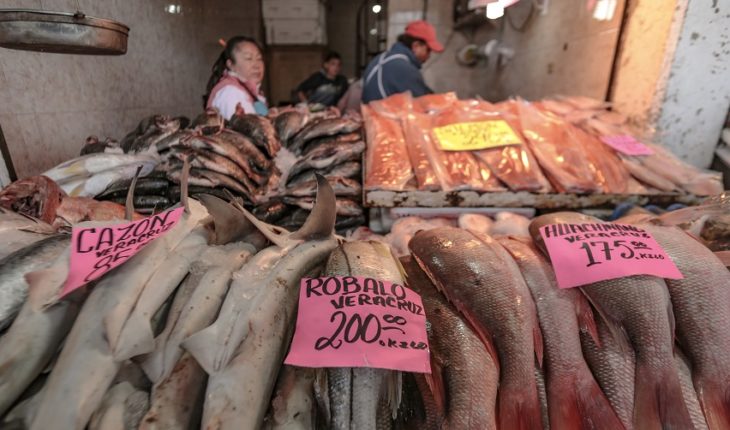just dawn and in the La Nueva Viga market there is a bustle of vendors and customers seeking the best fish. On metal plates or on ice, are stacked red snapper, Grouper, bream, perch, that hours later will be on the table in a restaurant, or in a fish market.
But in the way of the ocean to the plate of Mexican Diners there is a deception that not only affects the consumers pocket, also has environmental impacts, the maritime ecosystem and fisheries dynamics of the country.
A study of the Organization Oceana, which looks for the conservation of the oceans and its species, shows how the country is common practice of replacement of fish that, just to mention a case, while Diners choose marlin who actually receive the most of the time is smoked tuna. Although even with the study was that on two occasions the marlin was replaced by thresher shark, and one for silky shark.
This type of substitution occurs in restaurants, fishmongers and supermarkets. There are cases in which sold grouper, when in reality it is based; or it is thought that it is red snapper, but is catfish flag or dorado.
The swindle, explained the specialists of Oceana, also marketers consulted, not only affects the Pocket who purchase fish, also has environmental impacts in the marine ecosystem and fishery dynamics of the country.
Read: Profeco detects that 18 brands of tuna contain soy in their cans and not all warn consumer if people see that a species appears in all menus, concerns the people of Oceana, is given by the fact that there is an abundance in the seas hiding that perhaps this species is being overfished or have low presence in the sea, and there is no pressure so apply controls in order to recover it or strengthen it.
The Oceana study was conducted on 133 establishments, fishmongers, supermarkets and restaurants, in the city of Mexico, Cancun (Quintana Roo), and Mazatlan (Sinaloa).
Samples were collected, and then compared the trade name of each fish on sale with the scientific name, based on genetic information.
the result was, on average, 31% of replacement of species – in total were identified 116 cases of replacement.
in at least one of every three sales there was Jack Hare: people requested a type of fish, and actually put a different species in your dish. With price differences, in some cases, more than 200 pesos.
figures in general where arose the level higher replacement was in the fish, with a 36.5%; second restaurants, with 33.5%, and in third place the supermarkets, with 16.5%.
In terms of species, in the three cities the five most replaced were marlin, with a 95% replacement level; Sierra (89%); grouper (87%), Red Snapper (54%) and Snook (53%).
to analyze each one of the cities, the city of Mexico had a general level of 34% substitution, with the Golden (85%), Red Snapper (78%), grouper (100%), sea bass (50%) and marlin (83%) like most replaced fish.
In Cancun, the percentage of substitution in general was 26.5%; marlin (100% replacement) and grouper (80%) they were the more substituted species.
Lastly in Mazatlán, Sinaloa, the overall average of substitution was 31.6%, being more replacement marlin (100%), fish (100%) saw and the snapper (50%).
The authors of the research agree that the 383 samples obtained (123 samples in Mazatlan, 153 in the city of Mexico and 107 in Cancun) and their respective results, fail to be representative of all what is known as Mexican “fishery” System.
But the study, they point out, is “a picture” and a wake up call for authorities, people in the business of selling of fish and consumers, about the weaknesses in the chain of surveillance for maritime products, and how this can “invisibilization” there lack of certain species in Mexico.
differences in costs
one of the most striking situations which found Oceana, doing its study, was a hoax in a shop in Cancun, Quintana Roo, where used painting to “disguise” a species.
“We are in a same supermarket tuna sold as tuna to 399 pesos, and salmon to 599 pesos. The two were tuna. And that tuna (which did go through salmon) was painted pink”, says Director of campaigns for transparency in Oceana.
“At the supermarket it is difficult that there is confusion. It is not that the waiter was confused. there is a label that is selling you a tuna 200 pesos more expensive that what it costs in another same packaging. It seems there is an Idol behind. I hardly imagine supermarket tagging as well. It should be who sold to the supermarket”, he adds.
Other cases that detected Oceana: replacement of Red Snapper by catfish flag in a fish shop or premises of the city of Mexico. Data from the Ministry of economy over the prices on the beam, in August 2018 (month which corresponds to the period in which the study was conducted) per kilo of Red Snapper had a price of 110 pesos, and the catfish flag of 30 pesos. A difference of 80 pesos.
In another fish market, were told to consumers that sold them grouper at a price of 95 weight kilo, when it was also actually catfish flag, 30 pesos. A difference of 65 pesos.
Article 32 of the Federal law of protection the consumer sets that information or advertising regarding goods, products or services that are disseminated by any means or form, must be truthful, not induce to error or confusion.
Meanwhile, in the regulation of the Federal protection law consumer is mentioned that conduct or abusive commercial practices will be which “violate the rights that the law grants to consumers by virtue of its realization in a way misleading, excessive, arbitrary or” improper”.
animal politician Profeco, called to inquire about the results of the study of Oceana, and only responded with an information card, stating that “in the new scheme of verification and monitoring, complaint is acted citizen”, When detected irregular practices.
This year, they noted, have received complaints against different brands and presentations of prepacked tuna, that led to 3,142 immobilized products select brand Brand and 9 information requirements to the packagers main of tuna in the country, for inconsistencies in their labeling business information.
Photo: Carlo Echegoyenwhere starts the deception?
to read about these replacements, many may wonder how it is that in settlements people would not be account of that are letting you down with a fish that did not ask for, especially in cases where there is a difference in price so high.
In this regard, Luis Bourillón, representative in Mexico of the Council of Administration Marina (MSC, by its acronym in English), eco-labelling of fish globally leading organization, mentioned that in many cases the type of presentation of the dishes, the similarity between species and the fact that you give the fish into fillets, very difficult for common consumers distinguish the differences or realize the deception.
“If they bring you a fish fillet, bathed in a sauce and well seasoned, it is very difficult that with pure palate you can detect, or shaped like the filet, with consistency, unless you are a fisherman or a connoisseur” mentioned Bourillon.
Another question is, why does the replacement? At what moment? Are restaurant owners or owners of fishmongers who try to deceive customers? The distributors? Or at what point in the chain happens?
For their study, Oceana declined to give the names of the establishments in which sampled, because just ignore if own restaurateurs or owners of fishmongers, or even supermarket chains, might be deceived by a dealer.
In its conclusions, the NGO recognized that could not determine at what point in the chain replacement of species had occurred. Or if such replacement, in 133 establishments, was accidental or intentional.
consulted about whether there may be cases of corruption, where owners of establishments as restaurants could act with intent, both people of distributors as specialists agreed on mentioning that at any point in the chain, from inception to the final part, there may be undue actions.
“Where there is a dish, which are selling you mere, it should cost between 300 or 400 pesos per kilo, and actually give you based, which should cost about 100 pesos per kilo, if an accident is a very lucky accident for the seller”, says Pedro Zapata , Vice President of Oceana in Mexico.
“Delusions come at different levels, may be the intermediary selling a rule saying that it is one thing and giving you another, but also deception is much given to level restaurant, the restaurant has red snapper or bass, misplaced, and that currently there is no “, or is very expensive, they give you another thing and they don’t say it”, says concerning Pablo Ferrer, Manager of the Sargazo trading company.
The own Armando Vega, Manager of the Navigator, one of the most important distributors of the La Nueva Viga market, which is the second largest market of fish and seafood in the world, recognizes that there are people in the industry who do incur deception or unfair practices , as the replacement, although it is something that the industry seeks to combat.
“in the fact many people win win, gets a cheaper product and put it in his letter as another”mentions Vega.
These cases of substitution and other practices such as fishing ileGAL or improper, they mentioned the sources consulted, persist in Mexico due to the lack of controls or stricter inspections, scattering the responsibility of different authorities, the lack of more complete standards for labeling, and lack of awareness on the impact that there is.
Sea nourishes Mexicans, as economic activity generates about 11 billion pesos a year and their species diversity is in itself a great wealth, but Mexico does not enough to care for him.
Thanks for reading! Help us to continue with our work. How? You can now subscribe to political Animal on Facebook. With your monthly donation, you will receive special content. Find out how to subscribe here. Check our list of frequently asked questions here.
translated from Spanish: Deception in the sale of fish in Mexico
March 12, 2019 |





